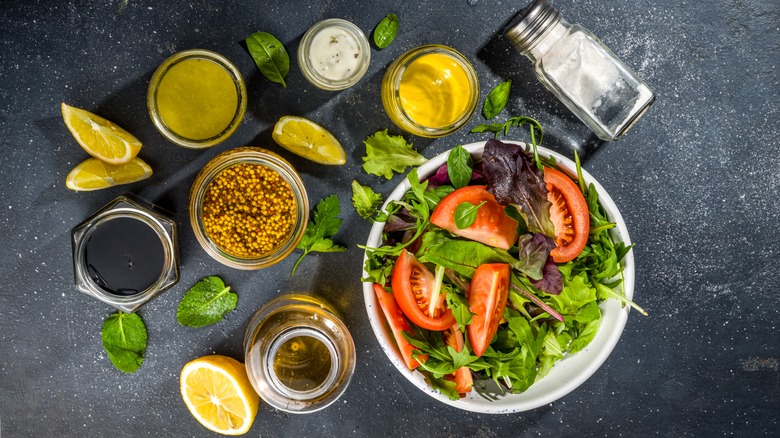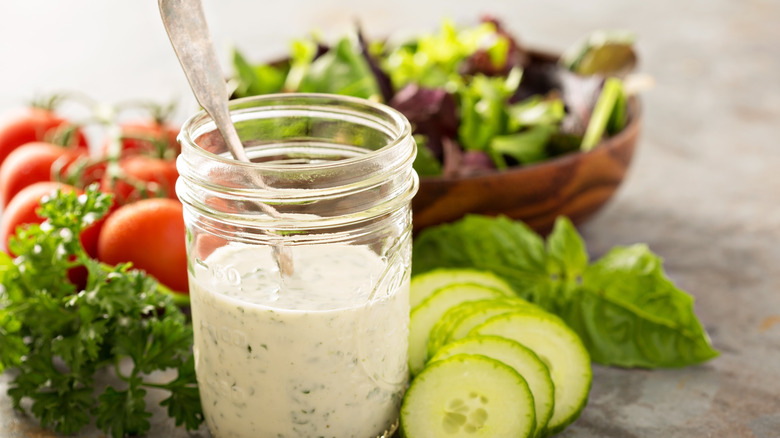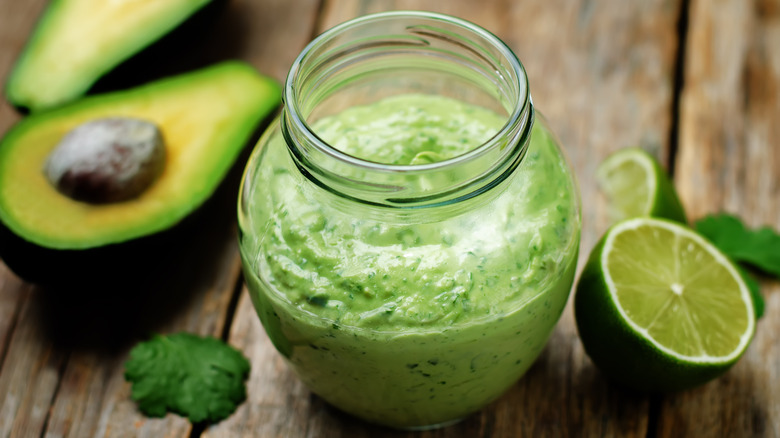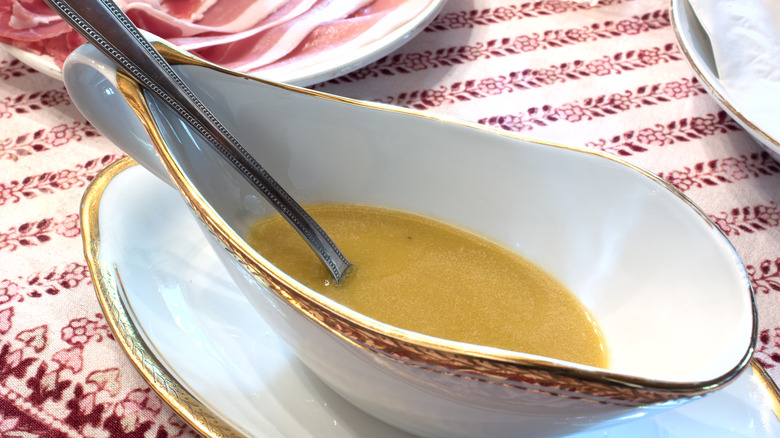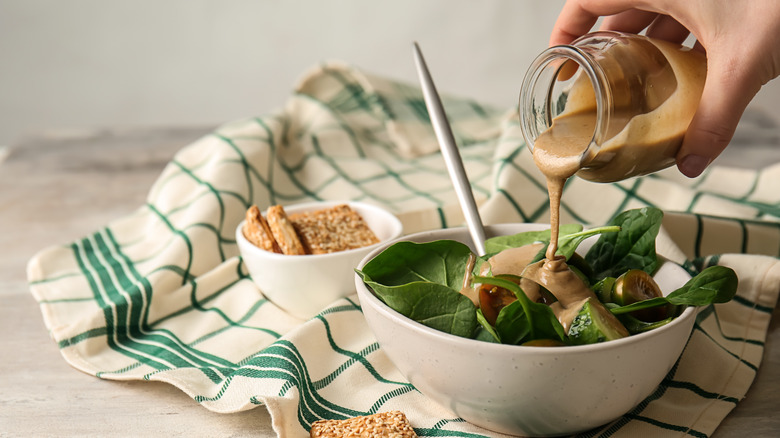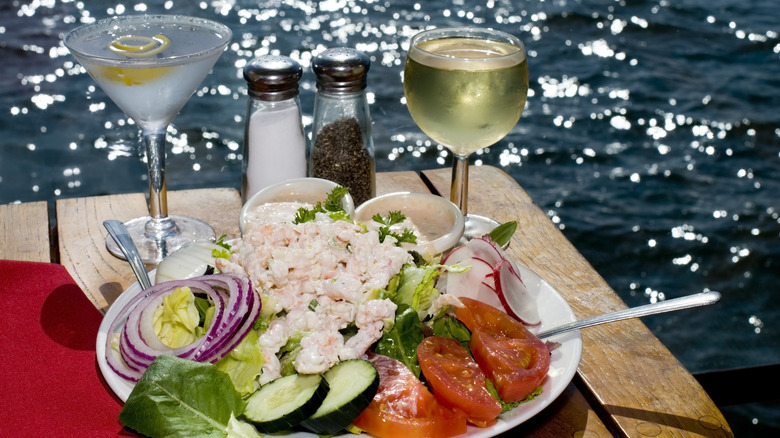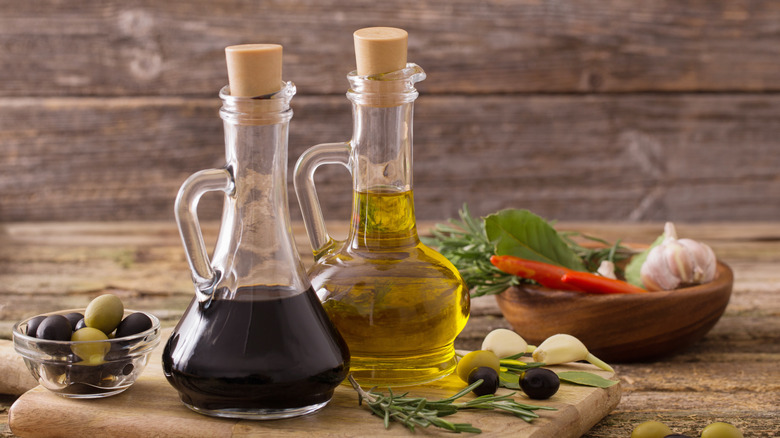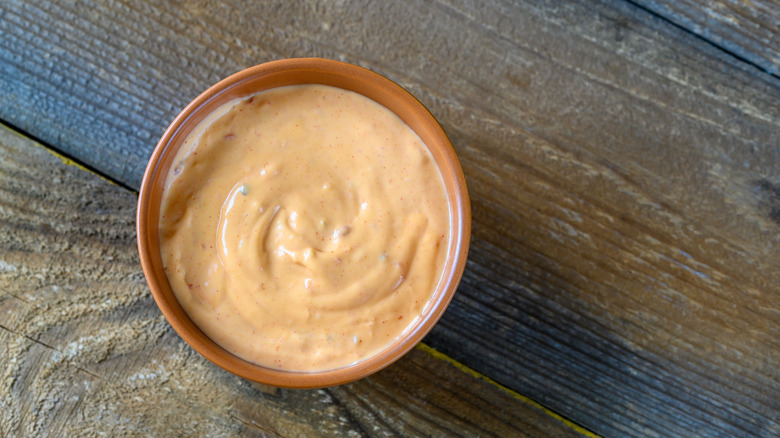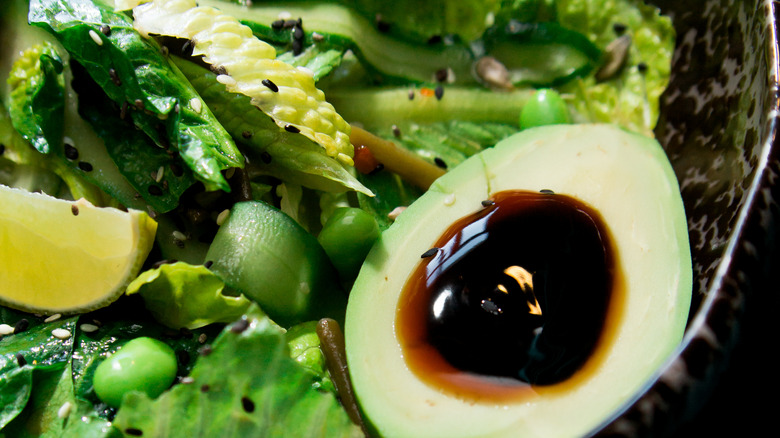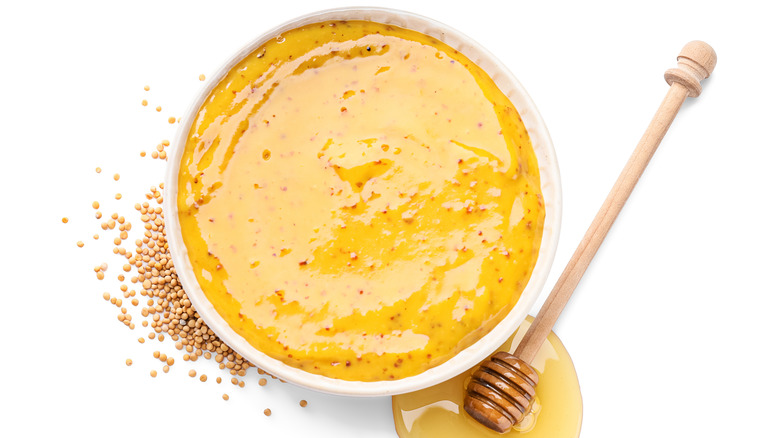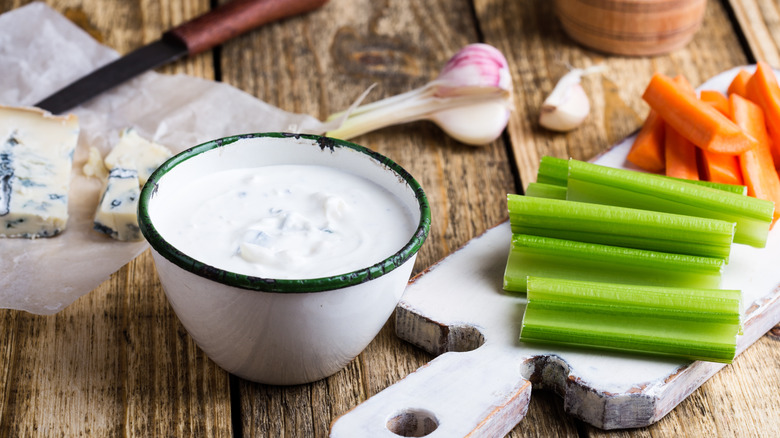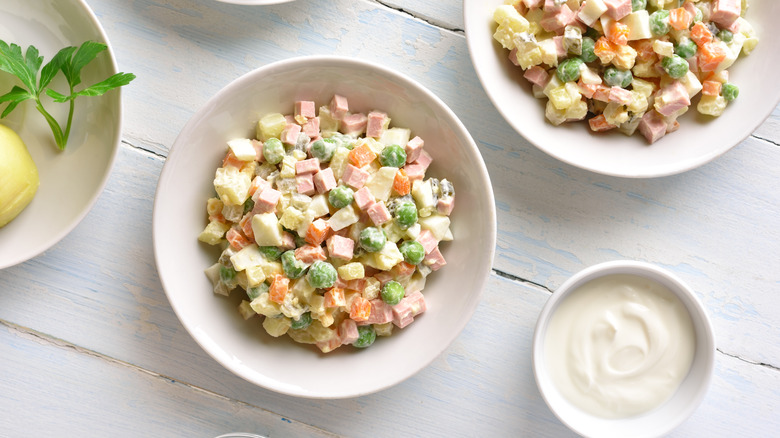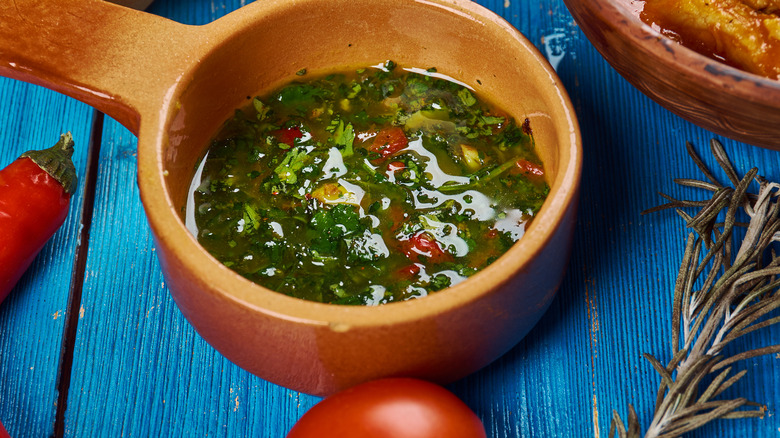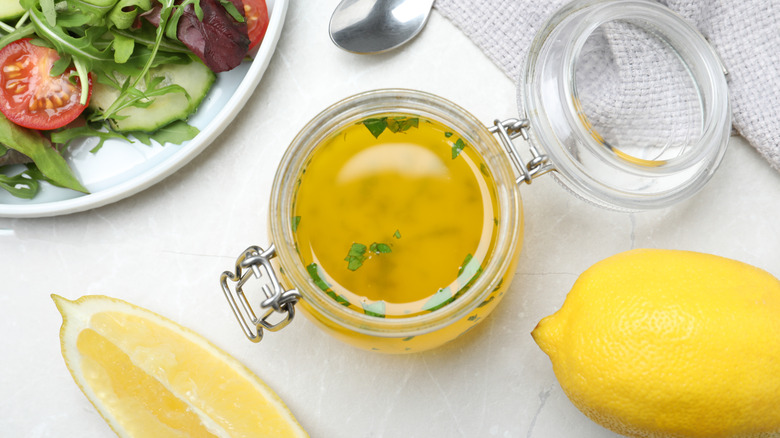The 13 Most Popular Salad Dressings Around The World
Thanks to popular culture, salads are cool again. From the Jennifer Aniston salad to those made in Mason jars, diners are embracing the humble salad like never before. We all know they are more than just a boring pile of greens, but what makes them really come together is the salad dressing.
Supermarket shelves are filled with bottles of dressing ranging from creamy to tangy to oily to chunky. While there are many choices, some dressings are more popular than others. While this healthy meal of greens and veggies is enjoyed around the globe, did you ever wonder what the most popular salad dressings are in different counties? We are taking a look at some of the popular salad dressings you'll find and the countries that can't get enough of them. Whether tossed in a simple salad or used as a dipping sauce, it's no secret the world loves salad dressings.
1. Ranch (U.S.)
In a 2017 survey by The Association of Salad Dressings and Sauces, it was shown that Ranch dressing is the most popular dressing in the U.S. The classic dressing starts with a mix of equal parts buttermilk and either sour cream or mayonnaise, then savory herbs and spices like parsley, dill, chives, onion, and garlic powder are mixed in to create a creamy dressing with a tanginess that goes well with just about everything.
The popular dressing came onto the scene in the 1950s in the Hidden Valley Ranch in California. It was a local favorite with fresh ingredients that didn't store well. In 1972, when the Clorox company bought the recipe, it managed to keep the unique flavor while making it shelf stable and available to consumers throughout the U.S.
Ranch dressing is more than just a salad dressing; diners dip spicy chicken wings and salty fries in it too. Pizza chains have capitalized on the public's love of Ranch, as well, making it into a dipping sauce for pizza slices.
2. Avocado cilantro lime (Mexico)
In Mexico, avocado is king, and before the days of expensive avocado toast, the country's citizens were the main consumers of it. The fruit had been a staple in the diet of diners south of the border since the time of the Aztecs, who mashed it with dried chilies and local herbs to create basic guacamole. Nowadays, avocados are the base for avocado cilantro lime dressing, which also includes cilantro and fresh lime juice.
Avocados are full of healthy fats that satisfy the tastebuds and give a rich mouthfeel, making this dressing a favorite in the region. You can find it everywhere, from restaurants to home kitchens to street food vendors. The avocado cilantro lime dressing is typically contained in plastic squeeze bottles making it easy to drizzle on spicy tacos, crunchy chalupas, and deep-fried empanadas.
3. French vinaigrette (France)
French cuisine is known for its gooey cheeses, thick crusty slices of bread, creamy sauces, and decadent desserts. While you may not think of salads when imagining a French dinner table, they are quite popular, especially in the beautiful French countryside where fresh vegetables are grown. One of the most popular dressings to top a salad in the region is a simple French vinaigrette. It is made with a mixture of olive oil, vinegar, and Dijon mustard and is perfect on the classic French Nicoise salad.
While the salad dressing starts with a common base, some versions add garlic and fresh herbs to enhance the flavor. It's common to use other kinds of vinegar, too, like white wine, red wine, or champagne varieties. The beauty of French salad dressing is that it is versatile and can be made with pantry staples. It is light with an acidic tang that is perfect for dressing up greens or drizzling on roasted veggies for a light and elegant bite.
4. Tahini (Middle East)
If you have ever made homemade hummus, then you are already familiar with tahini, a Middle Eastern pantry staple. Tahini is made from mashed sesame seeds and is used as a spread on flatbreads, a dip for falafel, and as a salad dressing.
Tahini, on its own, is thick and has a mild nutty flavor, but as salad dressing it is part of an ensemble of flavors. Some tahini dressings are made with a mix of miso, which packs umami richness. Other tahini dressings turn away from savory and lean toward the sweeter side instead with a maple syrup and lemon juice mix to sweeten the dressing and give it a bright flavor.
But tahini adds more than just flavor; it adds a rich texture without excessive fat. Many home cooks are turning to tahini as a replacement for dairy since it's dairy-free and rich in vitamins and antioxidants (via Healthline).
While tahini may be somewhat new to diners in the U.S., it has a long history throughout the Middle East. It was first mentioned as a condiment in 13th-century cookbooks. Since this creamy condiment works in savory and sweet dishes, it's easy to see why it's been a staple in the culinary world for so long.
5. Louis dressing (U.S.)
In the Pacific Northwest, the cuisine relies heavily on seafood like Dungeness crab and Chinook salmon, so it makes sense that the region is responsible for the popular seafood salad dressing, the Louis. Louis salad dressing is the key component to a seafood Louis salad with crispy greens, boiled eggs, chopped tomatoes, sliced cucumbers, and lemon wedges topped with fresh Dungeness crab or salad shrimp.
The base of the dressing is a simple mix of ketchup and mayonnaise, but the unique tangy flavor comes from the addition of chili sauce, horseradish, and Worcestershire sauce. The creamy, zesty dressing is the perfect complement to the delicate salty taste of seafood.
The popular seafood Louis salad is on menus throughout the region, but there is some debate as to who created it. It was on menus in Seattle and Portland around the same time in the early 1900s. However, San Francisco also claims credit for the popular salad dressing, with the city of Spokane claiming it was named after the owner of the historic Davenport Hotel.
6. Oil and vinegar (Italy)
Oil and vinegar dressing is made from a simple ratio of three parts oil to one part vinegar with a generous pinch of salt. This simple dressing is a popular way to dress a salad in Italy.
The dressing starts with extra virgin olive oil, as it's the ideal choice for its light texture and flavor. The choice of vinegar depends on taste and region. Many regions use mild white wine vinegar, while others opt for tangier red wine vinegar. In the North, where balsamic vinegar is produced, it's the popular choice for a salad.
In Italy, green salads are served dressed by the chef or home cook, and the oil, vinegar, and salt are added directly to the salad bowl. And while a three-ingredient dressing seems simple enough, the order that each is added is a debatable step in the process. Some home chefs argue that the right way to dress a salad is by adding the salt first, then the vinegar and oil, while others claim the oil should be the first thing added, followed by the vinegar and salt.
7. Thousand island (Canada and Northeast U.S.)
Thousand Island salad dressing is named after the small group of islands near the North Eastern Canadian border where it is believed to have been invented, although the inventor of the dressing is debatable. The popular dressing is made from ketchup, mayonnaise, pickle relish, white vinegar, hard-boiled eggs, red peppers, and paprika. The result is a dressing with a pinkish hue that adds a rich texture and flavor to a pile of greens.
Thousand Island is popular on more than just salads; it's the sandwich spread on the classic Rueben sandwich. It is also a popular dipping sauce for fries and onion rings in fast food restaurants. And at one time, there was even a rumor floating around that the famous dressing was the secret sauce at McDonald's, however, it was debunked by the chain.
8. Wafu (Japan)
Japanese Wafu dressing is popular throughout the country as a dressing, sauce, and marinade. Wafu translates to "Japanese style," and in this case, it refers to the type of dressing, which has a base of Japanese fermented vinegar, soy sauce, mirin, and vegetable oil.
The basic wafu dressing was introduced in the late 1970s, and later as it grew in popularity, more versions were made with variations that included toasted sesame seeds, herbs, aromatics, seaweed, and dried fish flakes. Some versions of wafu mix the base with pureed vegetables like onion, garlic, ginger, or peppers, making it thicker than a vinaigrette and perfect as a marinade for chicken, tofu, or seafood.
You may need to take a trip to your local international market to find wafu, as regular supermarkets may not carry it. Wafu is also excellent on a cold noodle salad, Japanese potato salad, or a dipping sauce for tempura.
9. Honey mustard (Germany)
German food is hearty, with smoked sausages, slabs of cheese, and thick rolls. One popular condiment in the country is mustard, which has long been a staple of the cuisine. In Germany, you can find mustard in three forms: whole seeds, powder, and spread. It ranges from sweet to mild to spicy hot and is used as a dipping sauce for pretzels and smoked sausages.
German mustard is used as more than just a condiment; it's made into dressing and sauces, too. Honey mustard sauce is a quintessential German sauce served with more than just salad. It is ladled over schnitzel, slathered on thick slices of bread, and even added to German potato salad.
The simple combination of sweet honey and sharp mustard was not invented in Germany, though. The sauce goes all the way back to ancient times when the two were used separately for medicinal purposes and later together as a type of glaze for pork and other meats.
10. Blue cheese (Ireland)
While we know that blue cheese originally came from the Roquefort region of France in the 7th century, the dressing is a more recent invention. Blue cheese dressing was mentioned in 1918 in Fannie Farmer's cookbook, and later, in 1928, the dressing made an appearance in the "Edgewater Hotel Salad Book," but under the original name of Roquefort dressing. Later, the name changed to blue cheese dressing because it was being made with other less expensive forms of blue cheese.
In Ireland in the 1980s, Irish cheesemakers began making their own Irish versions of blue cheese. With local blue cheeses becoming more widely available in the country, homemade versions of the dressing followed and became popular.
Creamy blue cheese salad dressing, with its thick texture and tangy taste, is made with a mix of buttermilk, sour cream, mayonnaise, garlic, vinegar, and blue cheese. While it's called blue cheese dressing, it would be equally correct to call it blue cheese dip, as it's mostly used as a dip in Ireland. Pubs across the country serve blue cheese as a dipping sauce with fried foods and burgers and the pungent flavor pairs perfectly with a strong Irish Stout.
11. Mayonnaise (Russia)
Mayonnaise is the classic condiment that elicits strong opinions — you either love it or hate it. But it's clear in Russia that it is more loved than hated because Russian cuisine features the creamy condiment in various classic dishes like the Olivier salad. The classic Olivier salad is a mix of vegetables like potato, carrots, and peas with cubes of meat, usually ham, all mixed with a generous amount of mayonnaise. Another popular Russian salad named "herring under a fur coat" heavily features mayonnaise between its layers of herring, hard-boiled eggs, and assorted vegetables. In Russia, the growing season is short, and many vegetables are pickled or canned, so it's not common to see many green salads. In the cold climate, salads mean a mix of vegetables and protein wrapped in a mayonnaise blanket.
During the Soviet times in Russia, mayonnaise was mass-produced and widely available, making it a staple in every home and restaurant. Chefs and home cooks learned how to use it to add flavor to everything from salads to meats to eggs. Mayonnaise, the simple mix of emulsified egg yolk, vinegar, and oil, continues to be a popular condiment in the country.
12. Chermoula (North Africa)
Chermoula is a household name in Morocco and other parts of North Africa. This mix of herbs and spices is more than just a salad dressing; it's a marinade, sauce, and dip too. The base includes coriander, garlic, and cumin; from there, the herbs and spices vary depending on the region but may include paprika, saffron, turmeric, cardamom, chilies, dill, and parsley. The seasonings are ground or blended into an aromatic paste, mixed with olive oil, and fresh lemon juice supplies the acidic binder to hold the flavors together. The flavorful paste is added to fish and seafood, poured on roasted vegetables, and used as a dipping sauce and dressing.
While it is difficult to know the exact history of the aromatic sauce, credit is given to the early indigenous people of North Africa, the Berbers. They were a nomadic tribe that was exposed to many spices and seasonings in their travels. In her book, The Food of Morocco, author Paula Wolfert explains that chermoula is not bound to any rigid recipe, and it depends not only on the regional spices but the chef's personalized additions too.
13. Lemon vinaigrette (Greece)
Situated in the ideal trading location to connect the East to the West, it's no surprise that Greek cuisine is a medley of dishes that have passed through the islands for centuries. One salad dressing that illustrates the unique trade route is the lemon vinaigrette. It combines lemons that were introduced from the Middle East with Greek olive oil to create a simple yet spectacularly popular salad dressing that is still a staple of Greek cuisine to this day.
Greek vinaigrette sometimes referred to as lemon vinaigrette or ladolemono, is different than other vinaigrettes because it relies on acidic lemon juice rather than vinegar for that pop of flavor. It follows the same ratio as vinegar-based vinaigrette, with three parts olive oil to one part fresh lemon juice. From there, fresh herbs, honey, or Dijon are added to the dressing. It is perfect for salads of all kinds, from the classic Greek tomato cucumber salad to Greek potato salad to a simple plate of greens, it adds a bright, fresh flavor.
